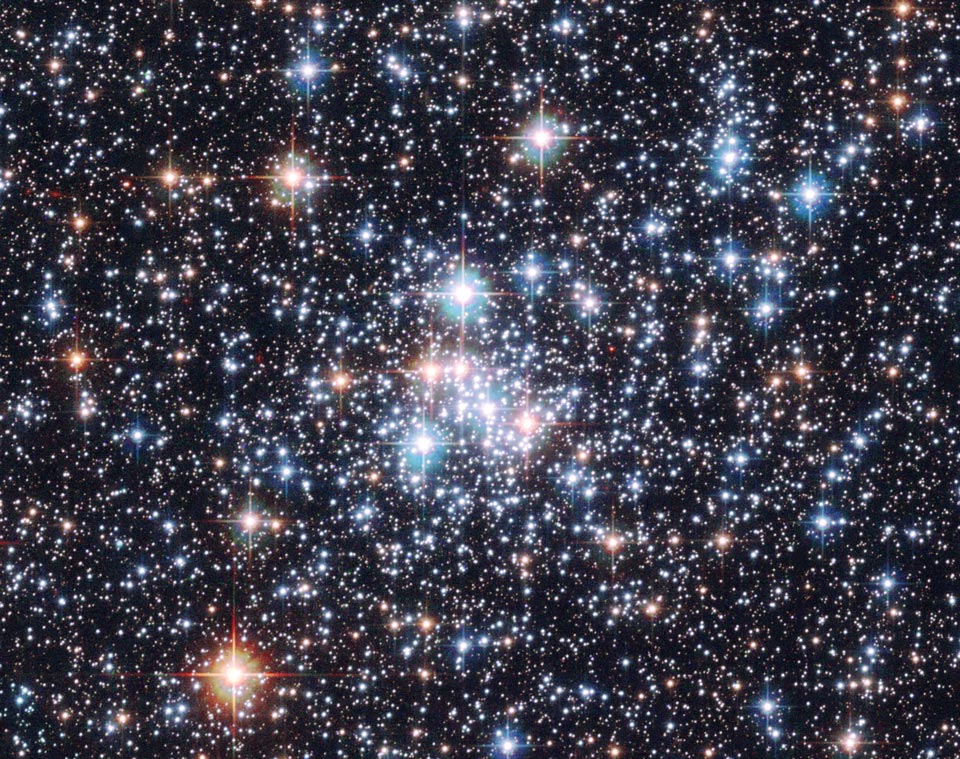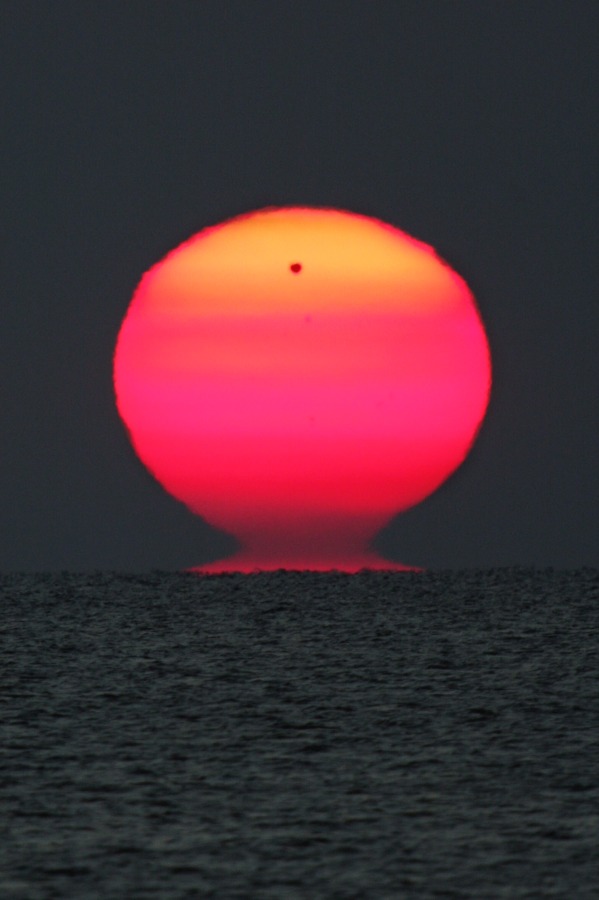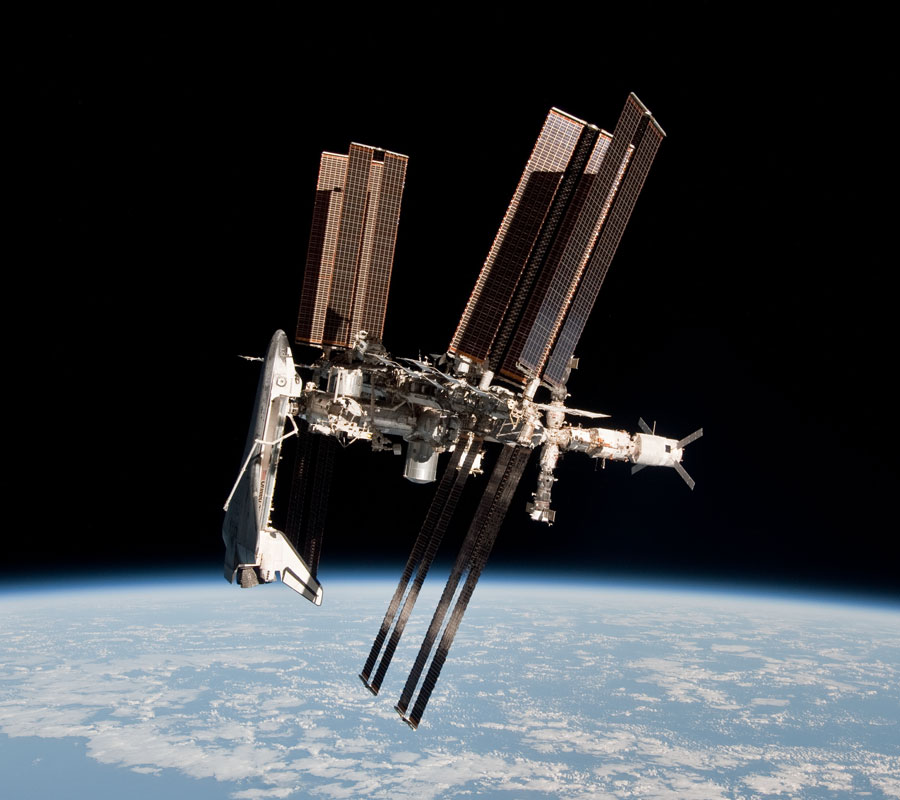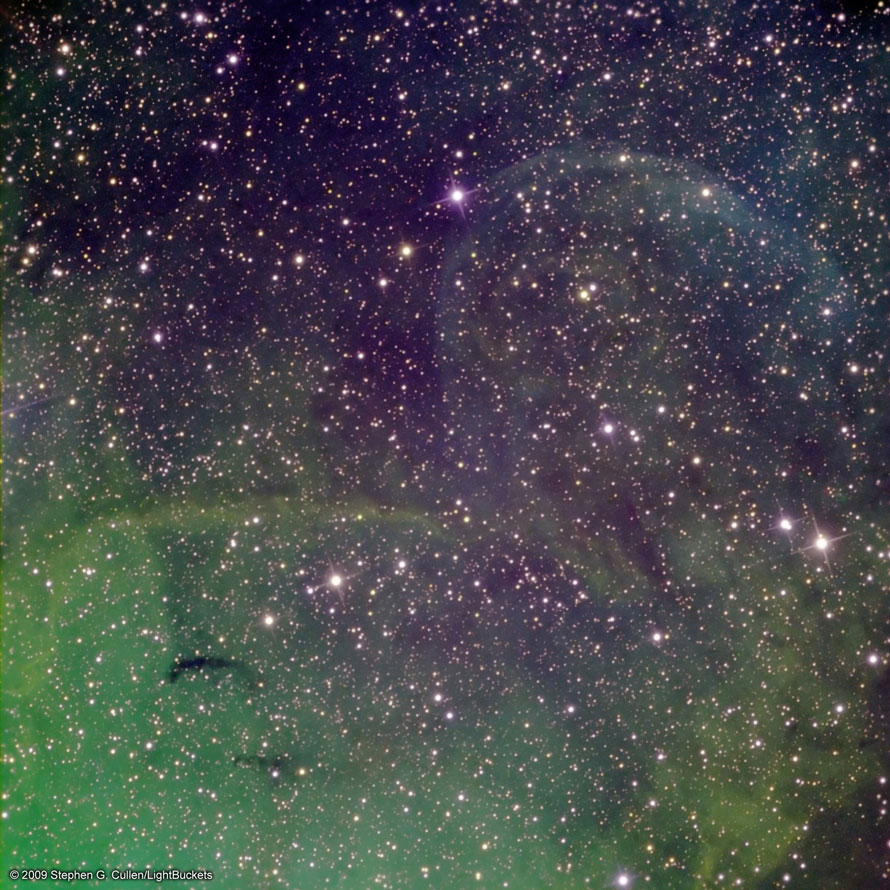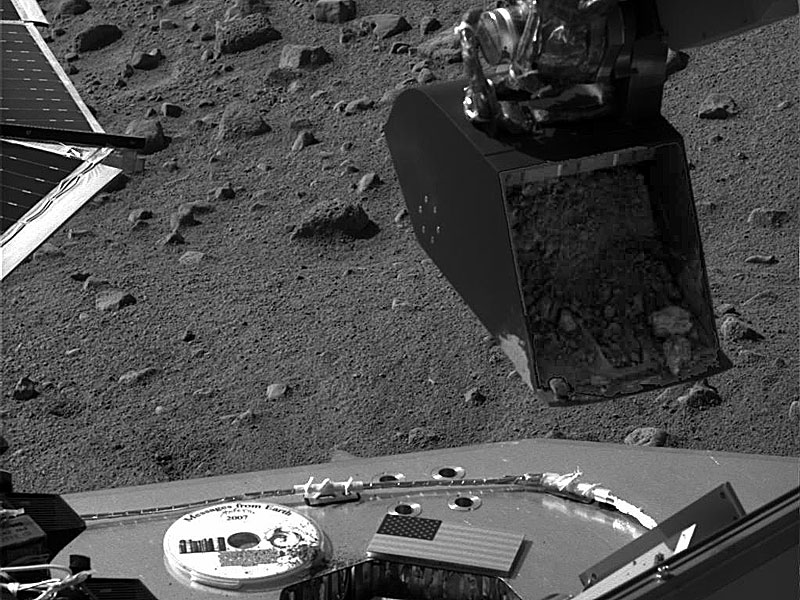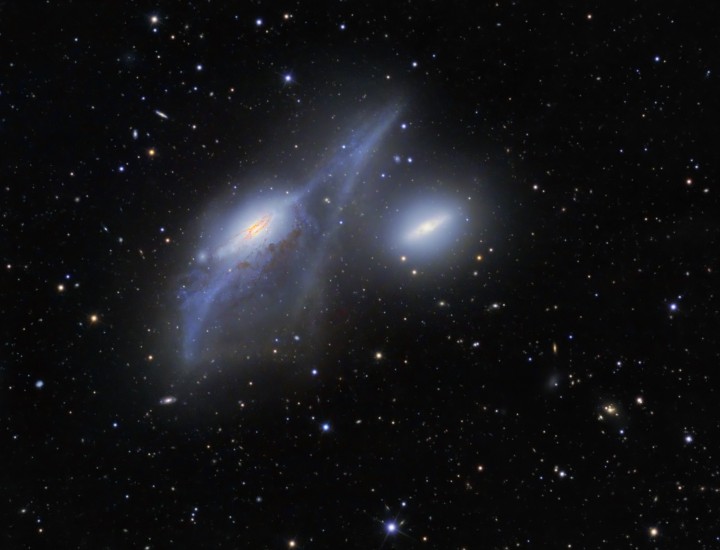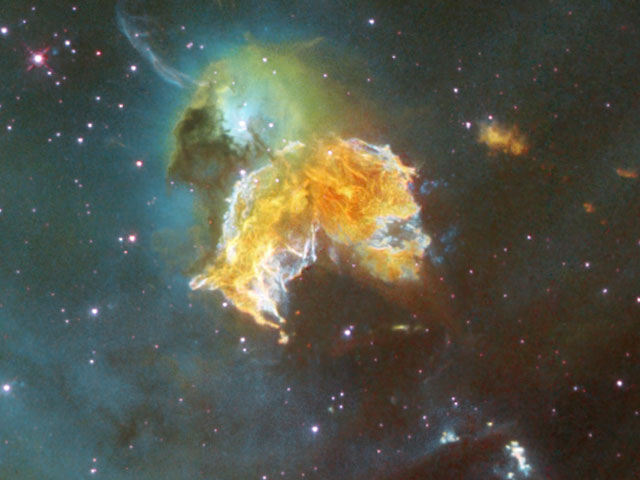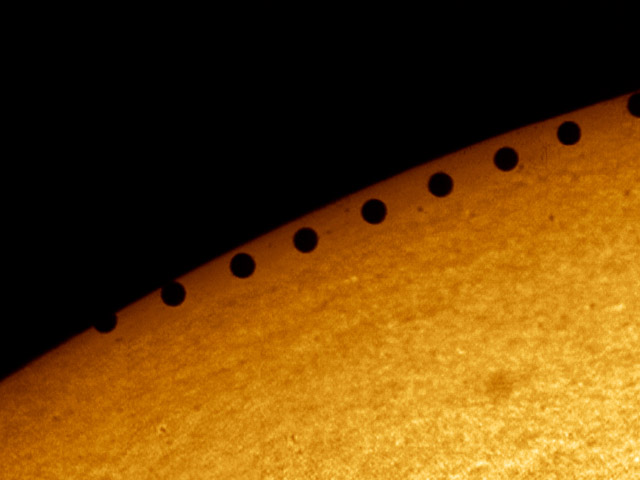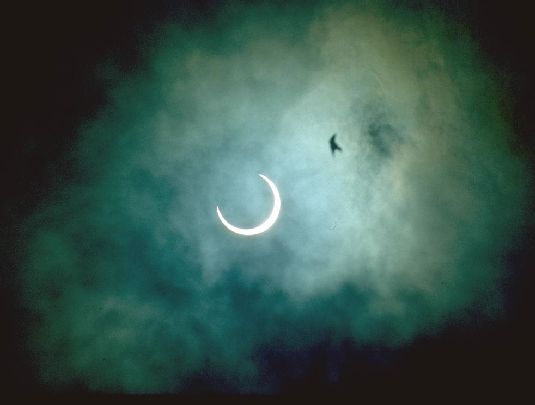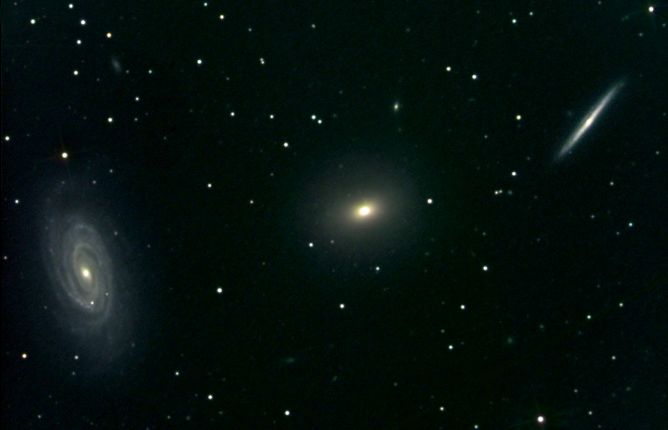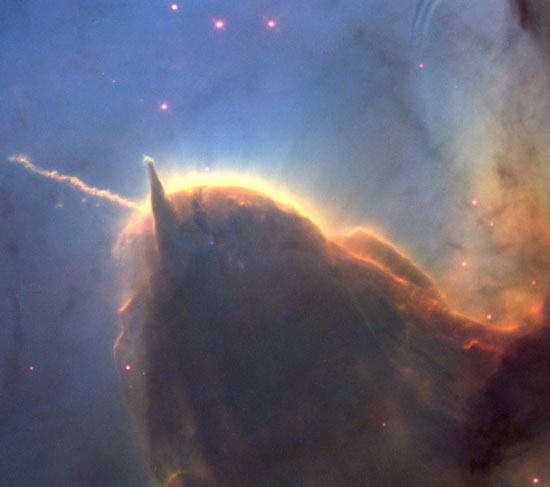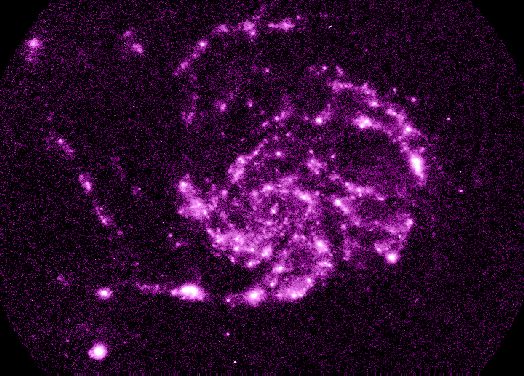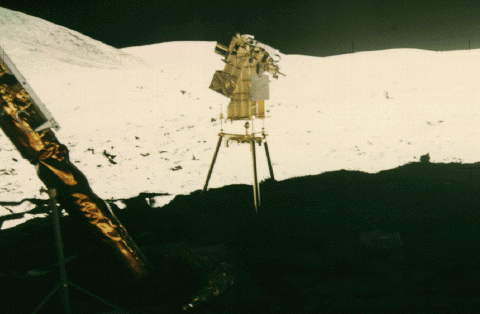| << Previous | Index | Next >> |
2015
[imghover6=http://apod.nasa.gov/apod/image/1506/Po ... os_960.jpg]http://apod.nasa.gov/apod/image/1506/Po ... otated.jpg[/imghover6]Image Credit & Copyright: Alexandros Maragos; Rollover Annotation: Judy Schmidt
2014 Jewels don't shine this bright -- only stars do. Like gems in a jewel box, though, the stars of open cluster NGC 290 glitter in a beautiful display of brightness and color. The photogenic cluster, pictured above, was captured recently by the orbiting Hubble Space Telescope. Open clusters of stars are younger, contain few stars, and contain a much higher fraction of blue stars than do globular clusters of stars. NGC 290 lies about 200,000 light-years distant in a neighboring galaxy called the Small Cloud of Magellan (SMC). The open cluster contains hundreds of stars and spans about 65 light years across. NGC 290 and other open clusters are good laboratories for studying how stars of different masses evolve, since all the open cluster's stars were born at about the same time.
2013 Many bright nebulae and star clusters in planet Earth's sky are associated with the name of astronomer Charles Messier, from his famous 18th century catalog. His name is also given to these two large and remarkable craters on the Moon. Standouts in the dark, smooth lunar Sea of Fertility or Mare Fecunditatis, Messier (left) and Messier A have dimensions of 15 by 8 and 16 by 11 kilometers respectively. Their elongated shapes are explained by an extremely shallow-angle trajectory followed by the impactor, moving left to right, that gouged out the craters. The shallow impact also resulted in two bright rays of material extending along the surface to the right, beyond the picture. Intended to be viewed with red/blue glasses (red for the left eye), this striking stereo picture of the crater pair was recently created from high resolution scans of two images (AS11-42-6304, AS11-42-6305) taken during the Apollo 11 mission to the moon.
2012 This dramatic telephoto view across the Black Sea on June 6 finds Venus rising with the Sun, the planet in silhouette against a ruddy and ragged solar disk. Of course, the reddened light is due to scattering in planet Earth's atmosphere and the rare transit of Venus didn't influence the strangely shaped and distorted Sun. In fact, seeing the Sun in the shape of an Etruscan Vase is relatively common, especially compared to Venus transits. At sunset and sunrise, the effects of atmospheric refraction enhanced by long, low, sight lines and strong atmospheric temperature gradients produce the visual distortions and mirages. That situation is often favored by a sea horizon.
2011 How was this picture taken? Usually, pictures of the shuttle, taken from space, are snapped from the space station. Commonly, pictures of the space station are snapped from the shuttle. How, then, can there be a picture of both the shuttle and the station together, taken from space? The answer is that during the Space Shuttle Endeavour's last trip to the International Space Station two weeks ago, a supply ship departed the station with astronauts that captured a series of rare views. The supply ship was the Russian Soyuz TMA-20 which landed in Kazakhstan later that day. The above spectacular image well captures the relative sizes of the station and docked shuttle. Far below, clouds of Earth are seen above a blue sea. The next and last launch of a US space shuttle is scheduled for early July.
2010
Click to play embedded YouTube video.
Credit & Copyright: SpaceX Co.
2009 What happens to matter that falls toward an energetic black hole? In the case of Cygnus X-1, perhaps little of that matter actually makes it in. Infalling gas may first collide not only with itself but with an accretion disk of swirling material surrounding the black hole. The result may be a microquasar that glows across the electromagnetic spectrum and produces powerful jets that expel much of the infalling matter back into the cosmos at near light speed before it can even approach the black hole's event horizon. Confirmation that black hole jets may create expanding shells has come recently from the discovery of shells surrounding Cygnus X-1. Pictured above on the upper right is one such shell quite possibly created by the jet of microquasar and black hole candidate Cygnus X-1. Rolling your cursor over the image will bring up an annotated version. The physical processes that create the black hole jets is a topic that continues to be researched.
2008 What surprises are hidden in the soils of Mars? To help find out, the Phoenix Lander Phoenix Lander which arrived on Mars two weeks ago has attempted to place a scoop of soil in Phoenix's Thermal and Evolved-Gas Analyzer (TEGA). Pictured above, the dirt-filled scoop approaches one of TEGA's eight ovens. Once in the oven, a soil material will be baked and the emitted gasses categorized by a mass spectrometer. Quite possibly, some of the light colored material visible in the scoop has the same composition as the light material imaged near the foot of the Lander, which may be ice. Phoenix is scheduled to spend the next three months digging, baking and chemically analyzing its immediate surroundings to better understand Mars and whether the boundary between ice and soil was ever capable of supporting life.
2007 Across the heart of the Virgo Galaxy Cluster lies a string of galaxies known as Markarian's Chain. Prominent in Markarian's Chain are these two interacting galaxies, NGC 4438 (left) and NGC 4435 - also known as The Eyes. About 50 million light-years away, the two galaxies appear to be about 100,000 light-years apart in this sharp close-up, but have likely approached to within an estimated 16,000 light-years of each other in their cosmic past. Gravitational tides from the close encounter have ripped away at their stars, gas, and dust. The more massive NGC 4438 managed to hold on to much of the material torn out in the collision, while material from the smaller NGC 4435 was more easily lost. The remarkably deep image of this crowded region of the universe also includes many more distant background galaxies.
2006 In this stunning Saturnian vista - one in a series of artist's visions of volcanos on alien worlds - icy geysers erupt along narrow fractures in inner moon Enceladus. The majestic plumes were actually discovered by instruments on the Cassini Spacecraft during close encounters with bright and shiny Enceladus last year. Researchers now suspect the plumes originate from near-surface pockets of liquid water with temperatures near 273 kelvins (0 degrees C) - hot when compared to the distant moon's surface temperature of 73 kelvins (-200 degrees C). A dramatic sign that tiny, 500km-diameter Enceladus is surprisingly active, these ice volcanos hold out another potential site in the search for water and origin of life beyond planet Earth. Enceladus' ice volcanos also likely produce Saturn's faint but extended E ring.
2005
2004 Today an astronomical event will occur that no living person has ever seen: Venus will cross directly in front of the Sun. A Venus crossing, called a transit, last occurred in 1882 and was front-page news around the world. Today's transit will be visible in its entirety throughout Europe and most of Asia and Africa. The northeastern half of North America will see the Sun rise with the dark dot of Venus already superposed. Never look directly at the Sun, even when Venus is in front. Mercury's closer proximity to the Sun cause it to transit every few years. In fact, the above image mosaic of Mercury crossing the Sun is from two transits ago, in November 1999. Will anyone living see the next Venus transit? Surely yes since it occurs in 2012.
2003 Rhea is the second largest moon of Saturn, behind Titan, and the largest without an atmosphere. It is composed mostly of water ice, but has a small rocky core. Rhea's rotation and orbit are locked together (just like Earth's Moon) so that one side always faces Saturn. A consequence of this is that one side always leads the other. Rhea's leading surface is much more heavily cratered than its trailing surface. The above photograph was taken with the Voyager 1 spacecraft in 1980. NASA's Cassini spacecraft is currently on route to Saturn and will arrive in 2004.
2002 A lunar eclipse can be viewed in a leisurely fashion. Visible to anyone on the night side of planet Earth (weather permitting), totality often lasts an hour or so as the moon glides through the Earth's shadow. But a solar eclipse is more fleeting. Totality can last a few minutes only for those fortunate enough to stand in the path of the Moon's shadow as it races across the Earth's surface. For the April 29, 1995 annular solar eclipse, photographer Olivier Staiger was standing in Macara, Ecuador under partially cloudy skies. Just before the maximum annular eclipse phase he recorded this dramatic moment as a bird flew near the sun. The next solar eclipse, on June 10, will also be an annular one. Partial phases will be visible from eastern Asia, the Pacific Ocean and much of North America. Very accurate predictions of eclipses have long been possible.
2001 This intriguing trio of galaxies is sometimes called the NGC 5985/Draco Group and so (quite reasonably) is located in the northern constellation Draco. From left to right are face-on spiral NGC 5985, elliptical galaxy NGC 5982, and edge-on spiral NGC 5981 -- all within this single telescopic field of view spanning a little more than half the width of the full moon. While this grouping is far too small to be a galaxy cluster and has not been cataloged as a compact group, these galaxies do lie roughly 100 million light-years from planet Earth. On close examination with spectrographs, the bright core of the striking face-on spiral NGC 5985 shows prominent emission in specific wavelengths of light, prompting astronomers to classify it as a Seyfert, a type of active galaxy. Not as well known as other tight groupings of galaxies, the contrast in visual appearance makes this triplet an attractive subject for avid astrophotographers.
2000 Space Weather forcasters are predicting major storm conditions over the next few days as the active Sun has produced at least three strong flares and a large coronal mass ejection (CME) since Tuesday, June 6th. This recent false color X-ray image of the Sun shows the active region generating the explosive events, here the Sun's most intense source of X-rays, as the dominant bright area just above center. X-ray hot plasma suspended in looping magnetic fields arcs above this region, cataloged as AR9026. AR9026 appears as a large group of sunspots in visible light images. The three intense flares were all X-class events, the most severe class of solar flares based on X-ray flux measurements by the earth-orbiting GOES satellites. Energetic particles from the CME, associated with the second X-class flare, were directed toward planet Earth and could produce geomagnetic storms as early as today. Possible effects range from increased auroral displays to disruptions of satellite and communications systems and electrical power grids. But wait ... there's more! In the coming days AR9026, carried slowly across the Sun (from left to right) by solar rotation, is likely to produce even more solar flares.
1999 Dust pillars are like interstellar mountains. They survive because they are more dense than their surroundings, but they are being slowly eroded away by a hostile environment. Visible in the above picture is the end of a huge gas and dust pillar in the Trifid Nebula, punctuated by a smaller pillar pointing up and an unusual jet pointing to the left. The pink dots are newly formed low-mass stars. A star near the small pillar's end is slowly being stripped of its accreting gas by radiation from a tremendously brighter star situated off the above picture to the upper right. The jet extends nearly a light-year and would not be visible without external illumination. As gas and dust evaporate from the pillars, the hidden stellar source of this jet will likely be uncovered, possibly over the next 20,000 years.
1998 If aligned just right, even a planet can produce a glint. The above combined pictures of Mars make the red planet appear unusually elongated - Mars is really almost spherical. However, these pictures were taken when the Sun was nearly directly behind the Mars Global Surveyor (MGS) spacecraft. This created a view for MGS where every part of Mars that was visible was also illuminated by the Sun. From this vantage point, though, sunlight reflects off the Martian surface and atmosphere producing a bright spot in the center - a glint. The brightness, color, and extent of the glint carry valuable information about the composition and physical properties of Mars.
1997 This giant spiral galaxy, Messier 101 (M101), was photographed by the Ultraviolet Imaging Telescope (UIT). UIT flew into orbit as part of the Astro 2 mission on-board the Space Shuttle Endeavour in March 1995. The image has been processed so that the colors (purple to white) represent an increasing intensity of ultraviolet light. Pictures of galaxies like this one show mainly clouds of gas containing newly formed stars many times more massive than the sun, which glow strongly in ultraviolet light. In contrast, visible light pictures of galaxies tend to be dominated by the yellow and red light of older stars. Ultraviolet light, invisible to the human eye, is blocked by ozone in the atmosphere so ultraviolet pictures of celestial objects must be taken from space.
1996 The first and only lunar astronomical observatory was deployed by the Apollo 16 crew in 1972. The Far Ultraviolet Camera / Spectrograph used a 3-inch diameter telescope to photograph the Earth, various nebulae, star clusters, and the Large Magellanic Cloud. The camera is seen above placed in the shadow of the Lunar Module so it would not overheat. A leg of the Lunar Module enters the picture from the left. The camera took pictures in ultraviolet light which would normally be blocked by the Earth's atmosphere. The Far Ultraviolet Camera was created by George Carruthers (NRL), had a field of view of 20 degrees, and could detect stars having visual magnitude brighter than 11. 178 images were recorded in a film cartridge which was returned to Earth. The observatory stands on the Moon even today.
| << Previous | Index | Next >> |
